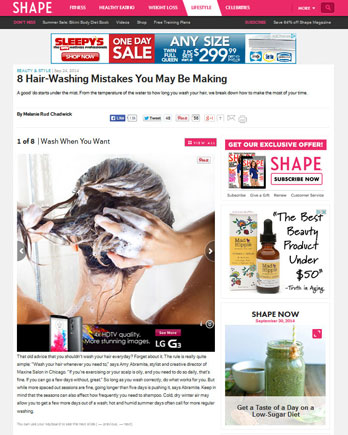Shape September 24, 2014
 Shape
Shape
September 24, 2014
8 Hair-Washing Mistakes You May Be Making
A good 'do starts under the mist. From the temperature of the water to how long you wash your hair, we break down how to make the most of your time.
Wash When You Want
That old advice that you shouldn’t wash your hair everyday? Forget about it. The rule is really quite simple: “Wash your hair whenever you need to,” says Amy Abramite, stylist and creative director of Maxine Salon in Chicago. “If you’re exercising or your scalp is oily, and you need to do so daily, that’s fine. If you can go a few days without, great.” So long as you wash correctly, do what works for you. But while more spaced out sessions are fine, going longer than five days is pushing it, says Abramite. Keep in mind that the seasons can also affect how frequently you need to shampoo. Cold, dry winter air may allow you to get a few more days out of a wash; hot and humid summer days often call for more regular washing.
Skip Shampoo
If you find that you need to wash everyday, try doing so sans shampoo. It may sound counterintuitive, but you can still get a similar refresh with water alone. “This will remove excess grime without stripping or drying out the scalp.” Finish by applying conditioner on the ends, blow-dry, and admire you’re newly refreshed ‘do.
Lather More Than Once
“One wash often isn’t enough to break down all the residue and product build-up, especially if you haven’t washed your hair for a few days,” says Abramite. Think about what you’d do with a muddy t-shirt: “You’d remove the big pieces of dirt and mud before you put it in the washing machine,” says Abramite. Similarly, when you wash your hair twice, the first round gets rid of the superficial gunk, while the second actually cleans it. How do you tell if you need to double up? Not being able to work the shampoo into a rich lather is a telltale sign that you need to rinse and repeat, she says.
Choose Your Temp
For those on the quest for a deep clean, keep your H2O warm; the heat opens the cuticle, improving the penetration of the shampoo. If your desired effect is a sleek, frizz-free style, turn the water to cool to close the cuticle. Avoid scalding temps at all costs; hot water dries out skin and hair, says Abramite.
Rinse It All Out
Stand under the spray for 30 seconds to one minute before you even reach for the bottle, Abramite suggests. “You need to give the water enough time to start rinsing out some of the product residue and prep the hair for shampoo.” And while it may seem silly to even say, be sure to completely rinse out shampoo and conditioner. “If your hair is falling flat or you have irritation on your scalp, it’s highly likely that you didn’t wash out all the product in the shower.”
Give Yourself a Massage
Don’t just slap on shampoo haphazardly. Work it in with your fingertips, in circular motions, starting at the hairline and moving down to the nape of your neck, advises Abramite. Massaging not helps create a thicker lather and makes for a more effective clean, it also stimulates the scalp, making for healthy hair growth in the long run. (Plus, it feels good!)
Pick the Right Product
Not all shampoos are considered equal. Choose one based on the style you want to achieve post-wash. Keep in mind that because volumizing options are lighter and contain fewer moisturizers, they can leave hair a bit tangly. Contrarily, hydrating formulas are rich in oils that will nourish strands, but can also weigh them down. Looking for a gentler option? Sudsers formulated to protect color-treated hair won’t open the cuticle as much, so they’re choice for a more mild cleanse, says Abramite. Try one if you’re shampooing daily.
Spot Treat
Regardless of the shampoo you use, concentrate it at the roots—the amount that naturally trickles down is enough for the ends. The opposite goes for conditioner, which should be reserved solely for tips. “Your ends contain the oldest and driest hair on your head,” says Abramite. “This is where you need conditioner the most. There’s no need to put it on the roots where it will just make your hair oily.” Work the majority into the very bottom of your hair, slathering on any leftover along the mid-shaft, but no higher.
